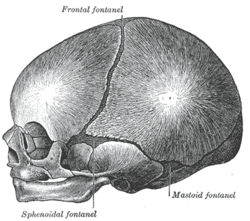Fontanelle
| Fontanelle | |
|---|---|

The skull at birth, showing the anterior and posterior fontanelles.
|
|

The skull at birth, showing the lateral fontanelles.
|
|
| Details | |
| Identifiers | |
| Latin | fonticuli cranii |
| TA | A02.1.00.027 |
| FMA | 75437 |
|
Anatomical terminology
[]
|
|
A fontanelle (or fontanel) (colloquially, soft spot) is an anatomical feature of the infant human skull comprising any of the soft membranous gaps (sutures) between the cranial bones that make up the calvaria of a fetus or an infant. Fontanelles allow for rapid stretching and deformation of the neurocranium as the brain expands faster than the surrounding bone can grow. Premature complete ossification of the sutures is called craniosynostosis.
During infancy, the anterior fontanelle is known as the bregma.
The skull of a baby consists of five main bones: two frontal bones, two parietal bones, and one occipital bone. These are joined by fibrous sutures, which allow movement that facilitates childbirth and brain growth.
During birth, fontanelles enable the bony plates of the skull to flex, allowing the child's head to pass through the birth canal. The ossification of the bones of the skull causes the anterior fontanelle to close over by 9 to 18 months. The sphenoidal and posterior fontanelles close during the first few months of life. The closures eventually form the sutures of the neurocranium. Other than the anterior and posterior fontanelles, the mastoid fontanelle and the sphenoidal fontanelle are also significant.
In humans, the sequence of fontanelle closure is as follows:
The fontanelle may pulsate, and although the precise cause of this is not known, it is perfectly normal and seems to echo the heartbeat, perhaps via the arterial pulse within the brain vasculature, or in the meninges. This pulsating action is how the soft spot got its name – fontanelle is borrowed from the old French word fontenele, which is a diminutive of fontaine, meaning "spring". It is assumed that the term spring is used because of the analogy of the dent in a rock or earth where a spring arises.
...
Wikipedia
